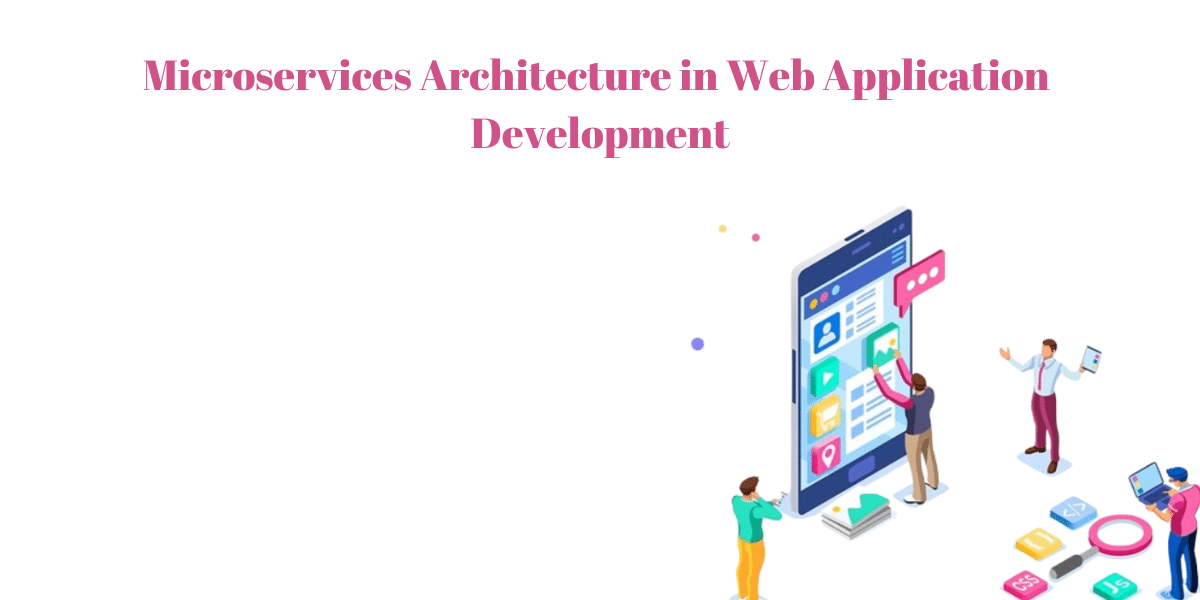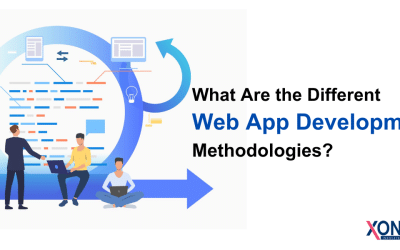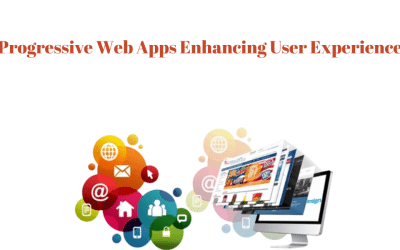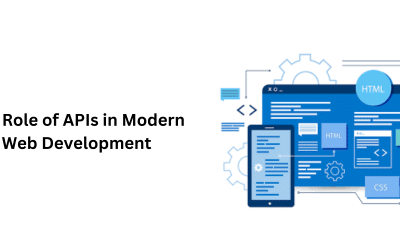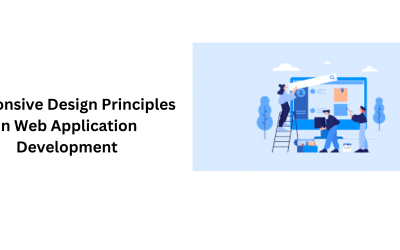Microservices architecture has emerged as a transformative paradigm in web application development, revolutionizing the way software is designed, deployed, and scaled. Unlike traditional monolithic structures, microservices break down applications into smaller, independently deployable services, each focused on a specific business capability. This architectural approach fosters agility, scalability, and efficiency, enabling organizations to respond swiftly to changing market demands. The introduction of microservices is driven by the need for modular, flexible systems that can adapt to evolving business requirements.
In this dynamic landscape, this exploration aims to delve into the intricacies of Microservices Architecture in Web Application Development. From fundamental principles to advanced implementation strategies, we will unravel the advantages, challenges, and best practices associated with microservices.
As organizations increasingly transition from monolithic architectures to microservices, understanding the nuances of this paradigm becomes pivotal for developers, architects, and decision-makers alike. This journey through microservices architecture will shed light on its transformative potential and empower stakeholders to harness its capabilities effectively.
Key Principles of Microservices Design
Microservices design is anchored in several key principles that shape the architecture and development process. First and foremost is the principle of modularity, which emphasizes breaking down applications into small, independent services, each responsible for a specific business function. This modularity facilitates easier development, testing, and deployment, as each service can be built, updated, and scaled independently.
Additionally, microservices adhere to the principle of autonomy, wherein each service operates independently, with its own database and codebase. This autonomy enables teams to make changes and updates to their services without impacting others, fostering agility and speed in web development. Another fundamental principle is the emphasis on decentralized data management, where each service manages its own data store, reducing dependencies and enhancing scalability. Furthermore, microservices embrace the concept of resilience, by employing techniques such as redundancy and fault tolerance to ensure system stability even in the face of failures.
Additionally, microservices prioritize the use of lightweight communication protocols such as REST or messaging queues, enabling efficient communication between services while minimizing overhead. Finally, microservices design principles advocate for continuous delivery and deployment, leveraging automation and CI/CD pipelines to streamline the release process and ensure rapid iteration. By adhering to these key principles, microservices architecture enables organizations to build scalable, resilient, and agile systems that can quickly adapt to evolving business needs.
Advantages of Adopting Microservices in Web Development
Adopting microservices architecture in web development brings forth a plethora of advantages that significantly impact the efficiency, scalability, and agility of software systems. One key advantage is enhanced scalability, as microservices allow for individual services to be scaled independently based on specific requirements, optimizing resource utilization and accommodating variable workloads. Additionally, microservices promote faster development cycles and deployment through their modular nature, facilitating parallel development and enabling teams to work on different services concurrently.
This modularity also contributes to increased flexibility, as changes or updates to one service do not necessitate alterations in the entire system, fostering agility and reducing web application development bottlenecks. Another notable advantage is improved fault isolation – in a microservices environment, if one service encounters an issue or failure, it does not necessarily disrupt the entire application, enhancing system resilience.
Microservices also align with diverse technology stacks, allowing developers to choose the most suitable tools and technologies for each service, promoting innovation and adaptability. Furthermore, microservices facilitate a more efficient use of resources, as organizations can allocate resources based on the specific needs of each service, optimizing costs and performance.
The adoption of microservices also aligns with the principles of DevOps, fostering collaboration and streamlined workflows between development and operations teams. Overall, the advantages of adopting microservices in web development extend beyond technical considerations, influencing the organizational culture, responsiveness to change, and the overall success of modern software systems.
Scalability Benefits in Microservices Architecture
The scalability benefits inherent in microservices architecture are a driving force behind its widespread adoption in modern software development. Microservices offer unparalleled scalability by allowing individual services to be independently scaled based on specific needs. This modular approach enables organizations to allocate resources efficiently, avoiding the need to scale the entire application when only a specific component requires increased capacity.
As a result, microservices architecture accommodates dynamic workloads more effectively, providing a scalable solution for applications with varying demand patterns. This fine-grained scalability not only optimizes resource utilization but also contributes to cost efficiency, as organizations can scale only the services that require additional resources, minimizing unnecessary expenditures.
Furthermore, microservices facilitate horizontal scaling, enabling organizations to add more instances of a particular service to distribute the load and enhance overall system performance. This flexibility is particularly valuable in cloud-based environments where resources can be provisioned and de-provisioned dynamically. The modular nature of microservices also allows for seamless integration of new services or the removal of obsolete ones, promoting agility and adaptability to changing business requirements. Scalability in microservices extends beyond computational resources to encompass development teams, allowing organizations to scale their engineering efforts more effectively by assigning teams to work on specific services independently. In essence, the scalability benefits of microservices architecture not only optimize technical aspects of resource allocation but also empower organizations to respond nimbly to evolving demands in a cost-effective manner.
Decomposing Monolithic Applications into Microservices
Decomposing monolithic applications into microservices is a strategic process that has gained prominence as organizations seek to enhance agility, scalability, and maintainability in their software systems. Monolithic applications, characterized by a single, tightly integrated codebase, often face challenges in adapting to changing business requirements and scaling efficiently. The process of decomposition involves breaking down the monolith into smaller, independently deployable microservices, each responsible for a specific business function.
This transition allows organizations to overcome the limitations of monolithic architecture by promoting modularity and granularity in system design. One of the key advantages lies in the ability to develop and update individual services independently, enabling faster release cycles and reducing the risk of system-wide failures during updates. Decomposing monolithic applications also facilitates scalability, as organizations can scale specific services based on demand without affecting the entire application.
Moreover, the microservices approach enables teams to choose diverse technology stacks for different services, aligning technology choices with the unique requirements of each component. While the decomposition process is transformative, it requires careful planning to manage dependencies, data consistency, and communication between microservices. Implementation challenges aside, the benefits extend beyond technical aspects to organizational agility, as teams can work autonomously on different services, fostering a more efficient and collaborative development environment. In essence, the decomposition of monolithic applications into microservices represents a strategic shift that empowers organizations to adapt to the complexities of modern business landscapes while enhancing scalability, maintainability, and overall system resilience.
Effective Communication Between Microservices
Effective communication between microservices is a critical aspect of building and maintaining a successful microservices architecture in web development. The modular nature of microservices implies that different services need to interact seamlessly to achieve the overall functionality of an application.
One key principle is adopting lightweight communication protocols, such as RESTful APIs or message queues, which facilitate efficient and scalable communication between services. RESTful APIs, based on standard HTTP methods, provide a stateless and language-agnostic approach, ensuring interoperability between diverse microservices. Message queues, on the other hand, enable asynchronous communication, allowing services to communicate without being directly connected, promoting flexibility and resilience.
Service discovery mechanisms play a crucial role in effective communication, allowing microservices to locate and communicate with each other dynamically. Technologies like Kubernetes or Consul provide service discovery capabilities, ensuring that services can adapt to changes in the environment, such as scaling or failure recovery. Implementing a robust API gateway further streamlines communication by centralizing the entry point for external requests, handling authentication, load balancing, and routing requests to the appropriate microservices.
Additionally, event-driven architectures contribute to effective communication by enabling services to react to events or changes in the system asynchronously. This reduces dependencies and allows for a more loosely coupled system. Nevertheless, challenges such as data consistency and eventual consistency must be carefully addressed to maintain the integrity of the overall application. In summary, effective communication between microservices is a multifaceted endeavor that involves choosing appropriate protocols, implementing robust service discovery mechanisms, and leveraging event-driven architectures to build a scalable, resilient, and loosely-coupled system.
Containerization and Microservices Integration
Containerization has become a linchpin in the successful integration of microservices, reshaping the landscape of web development by offering a lightweight, portable, and scalable solution for deploying and managing microservices at scale. Containers, encapsulating an application and its dependencies, provide a consistent runtime environment across different stages of development, testing, and production, addressing the common challenge of “it works on my machine” discrepancies. Platforms like Docker have gained widespread adoption due to their ability to package microservices into isolated containers, enabling easy web app deployment and horizontal scaling.
The synergy between containerization and microservices is evident in the flexibility they provide. Microservices can be developed, tested, and deployed independently within containers, allowing for rapid iteration and continuous integration/continuous deployment (CI/CD) practices. Container orchestration tools such as Kubernetes further enhance the integration, automating the deployment, scaling, and management of containerized microservices. This orchestration streamlines the coordination between microservices, optimizes resource utilization, and ensures high availability.
Moreover, the portability of containerized microservices simplifies cross-environment deployment, facilitating seamless transitions between on-premises and cloud infrastructures. The scalability benefits of containers align with the dynamic nature of microservices, as individual containers can be scaled up or down based on specific service requirements.
While the integration of containerization and microservices offers numerous advantages, it also introduces challenges such as network management, data consistency, and security, which must be carefully addressed to fully harness the potential of this powerful combination in modern web application development.
Microservices and Continuous Integration/Continuous Deployment (CI/CD)
The integration of microservices with Continuous Integration/Continuous Deployment (CI/CD) practices has become integral to modern software development methodologies, redefining the speed, reliability, and efficiency of the deployment pipeline. Microservices inherently embrace the principles of CI/CD, aligning with the need for rapid and automated delivery of software updates. CI/CD pipelines automate the entire software release process, from code integration and testing to deployment, ensuring that changes are consistently applied across microservices.
The modular nature of microservices allows development teams to independently work on specific services and integrate their changes seamlessly into the overall application through automated CI/CD workflows.
Continuous Integration involves the frequent merging of code changes into a shared repository, triggering automated build and test processes to identify and address issues early in the development cycle. Continuous Deployment extends this by automating the release and deployment of validated changes into production environments, reducing manual intervention and minimizing the time between code changes and their availability to end-users. This approach not only accelerates the delivery of new features but also enhances the overall stability of the application.
Microservices’ granular architecture facilitates parallel development and testing, allowing teams to work on different services simultaneously. CI/CD pipelines can be customized for each microservice, enabling independent testing and deployment cycles. Containerization technologies, such as Docker, further streamline the CI/CD process by providing consistent environments across development, testing, and production stages. Despite its transformative impact, implementing CI/CD for microservices introduces challenges, including managing dependencies between services, ensuring version compatibility, and addressing data migration complexities, emphasizing the need for a comprehensive approach to achieve seamless automation and reliable deployment in microservices architectures.
Microservices Security Best Practices
Implementing robust security measures is paramount in a microservices architecture to safeguard against potential vulnerabilities and ensure the integrity of the overall system. A fundamental security best practice in microservices is adopting a Zero Trust model, treating every service as a potential security risk, and implementing strict access controls.
Authentication and authorization mechanisms must be enforced at both the service level and the API gateway to authenticate incoming requests and ensure that only authorized users or services can access specific resources. The use of secure communication protocols, such as HTTPS or mutual TLS, is essential to encrypt data in transit and mitigate the risk of eavesdropping or man-in-the-middle attacks.
Microservices should employ proper identity and access management (IAM) solutions to manage user identities, roles, and permissions effectively. Additionally, implementing token-based authentication and authorization mechanisms, such as OAuth 2.0, enhances security by ensuring secure access to resources. Regular security audits, code reviews, and penetration testing are crucial for identifying and mitigating vulnerabilities in the codebase. Container security practices, including regular patching, image scanning, and runtime protection, are imperative, as microservices often leverage containerization technologies.
Furthermore, logging and monitoring should be robustly implemented across microservices to detect and respond to security incidents promptly. Securely managing configuration data, employing secrets management solutions, and encrypting sensitive data at rest are integral aspects of comprehensive microservices security. As the microservices landscape evolves, staying informed about emerging security threats and adhering to these best practices will fortify the resilience of the entire system against potential security breaches.
Data Management in Microservices: Strategies and Considerations
Efficient data management is a critical aspect of microservices architecture in web app solutions, demanding careful consideration and strategic planning to ensure seamless operation and maintain data consistency across the distributed system. One fundamental strategy involves embracing the concept of polyglot persistence, allowing each microservice to use the most suitable data storage technology for its specific requirements. This approach recognizes that different services may have distinct data storage needs and enables the selection of databases, both relational and NoSQL, that align with the service’s functionality.
Event sourcing and Command Query Responsibility Segregation (CQRS) are additional strategies that enhance data management in microservices. Event sourcing captures and persists all changes to an application’s state as a sequence of events, facilitating auditing, versioning, and reconstruction of system state. CQRS, on the other hand, separates the read and write responsibilities, optimizing data models for each operation.
Moreover, distributed transactions must be approached with caution, as the traditional two-phase commit mechanism may hinder the autonomy and scalability of microservices. Instead, techniques like eventual consistency and compensating transactions should be considered to maintain data integrity across services. Implementing a well-defined data governance strategy, including data ownership, access controls, and versioning policies, is crucial to ensure data quality and compliance.
Additionally, API design plays a pivotal role in data management, with clear and standardized interfaces facilitating communication between microservices. As microservices evolve, so do their data management needs, requiring ongoing evaluation and adjustment of strategies to address scaling challenges, evolving data requirements, and changing business landscapes. Successful data management in microservices necessitates a holistic approach that balances consistency, flexibility, and scalability.
Monitoring and Logging in a Microservices Environment
Effective monitoring and logging are essential components in managing the complexity of a microservices environment, providing insights into the performance, health, and potential issues within the distributed system. In a microservices architecture, the dynamic and decentralized nature of services demands comprehensive monitoring strategies to ensure the reliability of the entire ecosystem. Real-time metrics, such as response times, error rates, and resource utilization, are crucial for identifying performance bottlenecks and proactively addressing issues.
Utilizing centralized logging solutions enables the aggregation of logs from various microservices, aiding in troubleshooting and root cause analysis across the system. Microservices should emit structured logs containing relevant contextual information, allowing for easier correlation and analysis.
Implementing distributed tracing mechanisms, such as OpenTelemetry or Zipkin, facilitates end-to-end visibility into the flow of requests across microservices, aiding in understanding latency and dependencies between services. Additionally, health checks and synthetic monitoring can be employed to ensure the continuous availability and proper functioning of microservices. The integration of monitoring tools with alerting systems enables timely notifications and proactive responses to potential incidents, preventing or minimizing service disruptions.
Security considerations are paramount in monitoring, necessitating the safeguarding of sensitive data contained in logs and metrics. Regularly reviewing and refining monitoring and logging configurations in response to evolving system requirements and changes in the microservices landscape ensures the effectiveness of these practices over time. Ultimately, a robust monitoring and logging strategy empowers organizations to maintain optimal performance, diagnose issues promptly, and enhance the overall reliability of their microservices-based applications.
Fault Tolerance and Resilience in Microservices
Building fault tolerance and resilience is crucial in the context for web app development company to ensure the continued availability and stability of a distributed system in the face of failures and unexpected issues. Microservices, being independently deployable and scalable, introduce new challenges related to service interactions, network latency, and potential failures of individual services.
To address these challenges, the implementation of resilient communication patterns, such as circuit breakers, retries, and timeouts, is essential. Circuit breakers prevent cascading failures by temporarily halting requests to a failing service, providing an opportunity for recovery. Retrying failed requests and setting appropriate timeouts help in handling transient errors and mitigating the impact of temporary service unavailability.
Furthermore, designing microservices with idempotent operations and stateless communication helps in achieving fault tolerance. Idempotent operations ensure that repeated executions of the same action yield the same result, allowing for safe retries without unintended consequences. Embracing the principles of Chaos Engineering, where controlled failures are introduced into the system to test its resilience, can be instrumental in identifying weaknesses and improving fault tolerance mechanisms.
Data redundancy and replication strategies also contribute to fault tolerance by ensuring that critical data is not stored in a single point of failure. Implementing health checks, automatic scaling, and dynamic load balancing mechanisms assist in adapting to changing workloads and redistributing traffic away from unhealthy services. Overall, the pursuit of fault tolerance and resilience in microservices involves a combination of architectural choices, communication patterns, and operational practices to fortify the system against disruptions and provide a robust and dependable user experience.
Microservices and DevOps Collaboration
The collaboration between microservices and DevOps represents a symbiotic relationship that enhances the agility, efficiency, and reliability of modern software development and deployment practices. Microservices architecture inherently aligns with DevOps principles, as both emphasize breaking down silos and fostering cross-functional collaboration. DevOps practices, such as continuous integration, continuous deployment, and automated testing, seamlessly integrate with microservices development, facilitating rapid and iterative releases of individual services.
The modular nature of microservices allows development and operations teams to work collaboratively on specific services, promoting a culture of shared responsibility and accountability throughout the entire software development lifecycle.
Collaboration in microservices and DevOps extends to infrastructure as code (IaC), where automation scripts define and manage the infrastructure needed for microservices deployment. This ensures consistency between web development, testing, and production environments, reducing the risk of configuration drift and enhancing the reproducibility of deployments. Containerization technologies, often used in microservices architectures, complement DevOps by providing a consistent runtime environment across different stages of development and facilitating seamless deployment across diverse infrastructure.
Moreover, the integration of monitoring and logging tools within the DevOps pipeline enhances observability, allowing teams to identify and address issues promptly. The collaborative approach promotes a feedback loop, where insights from monitoring and operational experiences inform iterative improvements in both microservices design and deployment processes. Ultimately, the collaboration between microservices and DevOps is foundational for achieving the rapid, reliable, and scalable delivery of software in the dynamic and distributed landscape of modern application development.
Role of APIs in Microservices Communication
APIs (Application Programming Interfaces) play a central and transformative role in facilitating communication and interaction between microservices within a distributed architecture. In the realm of microservices, each service encapsulates specific business functionalities, and APIs serve as the standardized interfaces through which these services communicate with one another.
RESTful APIs, often employed in microservices architectures, enable stateless communication over standard HTTP methods, offering a lightweight and scalable approach. APIs abstract the complexities of the underlying microservices, allowing for loose coupling and flexibility in the system’s design. This decoupling enables microservices to evolve independently, as long as they adhere to the agreed-upon API contracts, fostering agility and continuous development.
Moreover, APIs are instrumental in promoting interoperability and enabling microservices to be developed and maintained by different teams with diverse technology stacks. API versioning strategies ensure compatibility between evolving services, allowing for seamless transitions without disrupting existing consumers. API gateways serve as a centralized entry point for external requests, handling tasks such as load balancing, authentication, and routing, streamlining communication between microservices and external clients.
Event-driven APIs, based on asynchronous messaging patterns, further enhance the real-time communication between microservices by allowing them to react to events and changes in the system. This paradigm facilitates scalability, resilience, and a more loosely coupled system. In essence, the role of APIs in microservices communication extends beyond mere integration; it acts as the foundation for building modular, interoperable, and adaptive systems, empowering organizations to harness the benefits of microservices architecture in the dynamic landscape of modern application development.
Microservices Orchestration vs. Choreography
Microservices architecture provides two distinct approaches to manage communication and coordination between services: Orchestration and Choreography. Orchestration and Choreography represent different paradigms for achieving collaboration and synchronization in a distributed system of microservices. Orchestration involves a central controller, often referred to as an orchestrator or workflow engine, that governs the flow of interactions between microservices.
This central entity dictates the order and execution of tasks, ensuring a predefined sequence of steps in the overall process. While Orchestration provides a clear and centralized control mechanism, it may introduce a single point of failure and can become a bottleneck as the system scales.
On the other hand, Choreography adopts a decentralized approach, where each microservice is responsible for determining its actions based on events or messages it receives. In Choreography, services collaborate through asynchronous communication, reacting to events and updating their state accordingly. This approach distributes the control logic across services, offering flexibility and autonomy. However, Choreography can be challenging to manage as the complexity of interactions increases, making it crucial to establish clear communication protocols and ensure proper observability for troubleshooting.
Choosing between Orchestration and Choreography depends on the specific requirements and trade-offs of the application. Orchestration is suitable for scenarios with a well-defined flow of tasks, where central control is beneficial. In contrast, Choreography excels in situations demanding flexibility, autonomy, and scalability, making it well-suited for complex, event-driven systems. The decision between these approaches requires careful consideration of factors such as system complexity, maintainability, and the level of control desired in the microservices architecture.
Choosing the Right Technology Stack for Microservices
Selecting the right technology stack is a pivotal decision in the successful implementation of a microservices architecture, influencing the system’s performance, scalability, and maintainability. Key considerations in this process include programming languages, frameworks, databases, communication protocols, and deployment tools.
The polyglot nature of microservices often allows teams to choose the most suitable language and framework for each service based on its specific requirements. For example, lightweight and fast frameworks like Spring Boot or Node.js may be preferred for services requiring rapid development and high concurrency, while others may benefit from the robustness of frameworks like Django or ASP.NET.
Databases play a crucial role in microservices, with both relational and NoSQL databases finding their places based on the nature of the data and service requirements. Decisions regarding communication protocols, such as RESTful APIs or messaging queues, influence how microservices interact and exchange information.
Containerization technologies like Docker and orchestration tools like Kubernetes are instrumental for deploying and managing microservices at scale, providing consistency across development, testing, and production environments.
Consideration must also be given to monitoring and observability tools, ensuring visibility into the performance and health of individual services. The choice between synchronous and asynchronous communication patterns impacts the overall system’s responsiveness and fault tolerance. Ultimately, the right technology stack for microservices is a balance between the specific needs of each service, team expertise, and the organization’s overall architecture strategy. Regular evaluation and adaptation of the technology stack in response to evolving requirements, industry trends, and emerging technologies are essential for maintaining the agility and competitiveness of a microservices-based system.
Testing Strategies for Microservices Applications
Testing microservices applications demands a comprehensive strategy that addresses the challenges posed by the distributed, modular nature of the architecture. Unit testing, validating the functionality of individual services in isolation, is foundational. It ensures that each microservice functions as expected, detecting and resolving issues early in the development process.
Service integration testing focuses on verifying the interactions between microservices, ensuring seamless communication and compatibility in a real-world scenario. Contract testing becomes crucial, as it allows services to define and verify the contracts or agreements between them, guaranteeing that changes to one service do not inadvertently break others. Additionally, end-to-end testing is essential for validating the entire system’s behavior, often requiring tools that simulate user interactions across multiple services.
As microservices often rely on external dependencies and APIs, performance testing becomes vital to evaluate system scalability and responsiveness under various conditions. Implementing chaos engineering techniques, where controlled failures are introduced to assess system resilience, is valuable in identifying and mitigating potential weaknesses. Furthermore, automated testing frameworks and continuous integration/continuous deployment (CI/CD) pipelines streamline the testing process, ensuring rapid feedback and maintaining the integrity of the codebase.
Given the dynamic nature of microservices, a robust strategy includes a combination of testing methodologies, ranging from traditional to more modern practices. Investing in a comprehensive suite of tests, both automated and manual, enables organizations to confidently release updates, respond to changing business requirements, and maintain the reliability and quality of their microservices-based applications.
Microservices and Cross-Functional Teams in Agile Development
Microservices architecture and cross-functional teams form a symbiotic relationship in the agile web app development landscape, fostering an environment of flexibility, collaboration, and rapid innovation. Microservices inherently encourage a decentralized approach, where each service represents a distinct business capability, aligning well with the ethos of cross-functional teams.
These teams consist of individuals with diverse skills, including developers, testers, designers, and operations specialists, who collectively take ownership of end-to-end responsibilities for specific microservices. This alignment enables teams to work autonomously on their services, promoting faster decision-making, streamlined communication, and reduced dependencies on other teams.
The modularity of microservices architecture allows cross-functional teams to innovate and iterate rapidly on individual services without affecting the entire system. This approach aligns with agile principles, where the focus is on delivering small, incremental improvements frequently. Cross-functional teams also contribute to improved communication and understanding between different functional areas, breaking down silos and fostering a shared sense of responsibility for the overall success of the product.
In an agile microservices environment, the synergy between architecture and team structure accelerates the development lifecycle, enhances adaptability to changing requirements, and promotes a culture of continuous improvement. Challenges such as service ownership, collaboration, and ensuring consistent practices across teams must be managed, but the benefits of improved speed, innovation, and responsiveness outweigh these challenges. Overall, the combination of microservices and cross-functional teams is a powerful paradigm for organizations seeking agility, innovation, and effective collaboration in their software development processes.
Managing Dependencies in Microservices Architecture
Managing dependencies in microservices architecture is a critical aspect that demands careful consideration to maintain the autonomy, scalability, and resilience of individual services within a distributed system. Microservices, by design, aim to be loosely coupled, allowing each service to function independently. However, effective management of dependencies becomes crucial to ensure seamless communication and interoperability between services.
Versioning is a key strategy, enabling services to evolve independently while maintaining compatibility with other services that may rely on their functionality. The use of API contracts and well-defined interfaces establishes a clear understanding of the communication protocols and expectations between services, mitigating the risks associated with changes.
Dependency injection mechanisms, such as service registries or discovery patterns, facilitate dynamic service discovery, enabling microservices to locate and interact with each other in a decentralized manner. Despite the advantages of autonomy, it’s essential to carefully manage shared libraries and common dependencies to avoid introducing coupling between services inadvertently. Continuous integration and continuous deployment (CI/CD) pipelines play a crucial role in managing dependencies by automating the build, testing, and deployment processes, ensuring that changes in one service do not adversely affect others.
Furthermore, the adoption of containerization technologies like Docker facilitates the encapsulation of dependencies, minimizing compatibility issues between development, testing, and production environments. Effective monitoring and observability practices are also indispensable, providing insights into the health and performance of services, helping teams identify and address dependency-related issues promptly. In essence, managing dependencies in microservices architecture requires a combination of disciplined architectural choices, communication protocols, and operational practices to strike a balance between autonomy and collaboration within the overall system.
Event-Driven Architecture in Microservices Systems
Event-driven architecture (EDA) plays a pivotal role in enhancing the flexibility, responsiveness, and scalability of microservices systems, providing a dynamic and asynchronous model for communication between services. In an event-driven architecture, microservices communicate through the generation, propagation, and consumption of events, which represent meaningful occurrences or state changes within the system.
This decouples microservices, allowing them to operate independently and react to events without direct dependencies on other services. Event-driven communication patterns, such as publish-subscribe or message queues, enable real-time information flow and allow services to operate asynchronously, improving system responsiveness.
One key advantage of EDA in microservices is its ability to support loose coupling, where services remain independent and unaware of each other’s existence. Events act as triggers for actions, enabling microservices to react to changes in the system or external events without direct dependencies. This adaptability is crucial in dynamic environments where microservices need to scale, evolve, or be replaced without disrupting the overall system.
Moreover, event-driven architectures enhance fault tolerance and resilience. In the event of service failures or temporary unavailability, messages are queued or broadcasted, ensuring that information is not lost and can be processed once the service recovers. EDA also facilitates event sourcing, where the state of the system is reconstructed by replaying stored events, enabling a reliable audit trail and system recovery.
While event-driven architecture brings substantial benefits, it also introduces challenges such as ensuring event consistency, handling event ordering, and maintaining a clear understanding of the flow of events. Despite these challenges, when implemented effectively, EDA empowers microservices systems to be more adaptive, scalable, and responsive in the ever-changing landscape of modern application development.
Microservices and Database Design Patterns
Database design patterns in microservices architecture are crucial for managing data effectively in a distributed and modular environment. Unlike monolithic applications, microservices often require a rethink in terms of data storage strategies to accommodate the autonomy and independence of individual services. One prevalent pattern is the use of the Database per Service pattern, where each microservice has its own dedicated database.
This fosters autonomy, allowing services to select databases tailored to their specific requirements, such as relational, NoSQL, or in-memory databases. Another approach involves the use of the Shared Database pattern, where multiple services share a common database. However, careful consideration is required to avoid tight coupling and dependencies between services, ensuring changes to one service don’t inadvertently impact others.
Event Sourcing is a pattern that emphasizes storing the state of the system as a sequence of events. This approach supports auditing, traceability, and reconstruction of the system’s state by replaying events. CQRS (Command Query Responsibility Segregation) is often combined with Event Sourcing, segregating read and write responsibilities to optimize database structures for each operation. The Saga pattern is employed to manage distributed transactions across multiple microservices, maintaining data consistency in a system where traditional ACID transactions may not be feasible.
Microservices may also utilize patterns such as Materialized View and API Composition to optimize data retrieval and presentation. Choosing the right database design pattern depends on factors like data access patterns, consistency requirements, and the specific needs of each microservice. Ultimately, a thoughtful selection of database design patterns in a microservices architecture ensures that data is managed effectively, supporting the agility, autonomy, and scalability that characterize the microservices paradigm.
Micro Frontends: Enhancing User Interfaces in Microservices
Micro Frontends is an architectural approach that extends the principles of microservices to the user interface layer, offering a custom software solution to the challenges of developing and maintaining complex, modular user interfaces in microservices-based applications. In the traditional monolithic approach, the user interface is often tightly coupled with the backend, making it challenging to scale and evolve independently.
Micro Frontends address this by breaking down the frontend into smaller, self-contained modules that align with the microservices architecture. Each micro frontend represents a specific business capability or feature and is developed, deployed, and maintained independently. This fosters flexibility, allowing different teams to use diverse technologies, frameworks, and libraries that best suit their specific frontend requirements. Additionally, it enables teams to iterate and release frontend components autonomously, reducing dependencies and streamlining development processes.
The composition of the user interface is typically orchestrated on the client-side, allowing for dynamic integration of micro frontends at runtime. This approach supports incremental updates and changes to the user interface without necessitating a complete application redeployment. However, coordinating the interactions between micro frontends requires careful consideration, and implementing effective communication mechanisms, such as event-driven architectures or shared state management, becomes crucial. Micro Frontends enhance the maintainability, scalability, and agility of user interfaces in microservices applications, aligning the frontend development process with the principles of modularity and autonomy that characterize microservices architecture.
Common Challenges in Microservices Adoption and Solutions
The adoption of microservices, while offering numerous advantages, introduces common challenges that organizations must navigate to realize the full benefits of this architectural paradigm. One significant challenge lies in managing the complexity of a distributed system. Microservices entail numerous independent components, requiring effective strategies for service discovery, communication, and overall system orchestration. Solutions involve implementing robust service mesh technologies, like Istio or Linkerd, to manage communication and enable features such as load balancing and fault tolerance.
Another challenge involves data management, with microservices often requiring different databases and data storage strategies. Adopting polyglot persistence, where each microservice selects the most suitable database technology for its needs, helps address this challenge, but organizations must also implement data consistency mechanisms and carefully manage data migrations.
Maintaining operational visibility poses a challenge in a microservices environment. Organizations need to invest in comprehensive monitoring and logging solutions to gain insights into the health and performance of individual services. Tools like Prometheus or ELK Stack assist in tracking metrics and aggregating logs for effective troubleshooting. Additionally, ensuring security across microservices, especially with increased attack surfaces, requires a focused effort. Implementing identity and access management solutions, securing communication through protocols like HTTPS, and regularly auditing for vulnerabilities are essential steps.
Lastly, cultural shifts and organizational changes may present challenges. Adopting a DevOps culture, embracing continuous integration and continuous deployment (CI/CD) practices, and fostering effective communication between web development and operations teams are crucial for success. Overcoming these challenges demands a holistic approach, combining technological solutions, best practices, and organizational culture changes to ensure a smooth and successful transition to a microservices architecture.
Future Trends and Innovations in Microservices Development
The landscape of microservices development is continuously evolving, driven by technological advancements and the need for more scalable, resilient, and adaptable software architectures. One notable trend is the increased integration of serverless computing with microservices. Serverless architectures, exemplified by platforms like AWS Lambda or Azure Functions, enable developers to focus solely on code implementation without managing underlying infrastructure, enhancing scalability and reducing operational overhead.
Another emerging trend is the adoption of edge computing in conjunction with microservices. Edge computing leverages distributed computing resources closer to the end-users, enhancing real-time processing and reducing latency, particularly in applications requiring low-latency responses.
The convergence of microservices with artificial intelligence (AI) and machine learning (ML) is also gaining momentum. Integrating AI/ML models into microservices enables applications to make intelligent, data-driven decisions in real-time. Kubernetes, a widely used container orchestration tool, is evolving to support more intricate workloads, paving the way for enhanced scalability and resource management in microservices environments. Additionally, the maturation of service mesh technologies, such as Istio and Linkerd, is influencing the future of microservices development by providing advanced capabilities like traffic management, security, and observability.
As organizations increasingly embrace microservices architectures, the focus on DevOps practices is expected to intensify. Automation, continuous delivery, and monitoring will become more integral to streamline the development and deployment lifecycle. Overall, the future of microservices development is likely to be shaped by the continued fusion of cutting-edge technologies, enabling more efficient, scalable, and intelligent applications in response to the ever-evolving demands of the digital landscape.
The Key Takeaway
In conclusion, the evolution of microservices architecture has ushered in a transformative era in software development, offering a modular, scalable, and resilient approach to building applications. The adoption of microservices addresses the challenges posed by monolithic architectures, promoting autonomy, agility, and rapid development cycles.
Key principles such as loose coupling, service independence, and decentralized control underscore the flexibility inherent in microservices. The growing trends of serverless computing, edge computing, and the integration of artificial intelligence reflect the dynamic nature of microservices development, pushing the boundaries of what is achievable in modern applications.
As organizations navigate the complexities of microservices adoption, embracing best practices in areas like security, monitoring, and DevOps becomes imperative. Looking forward, the continuous innovation and convergence of technologies are poised to shape the future of microservices, empowering developers to create sophisticated, intelligent, and highly responsive applications in the ever-evolving digital landscape.

